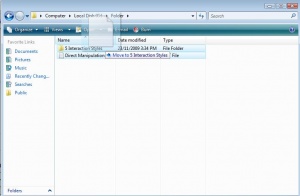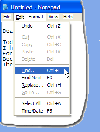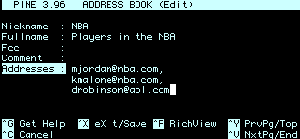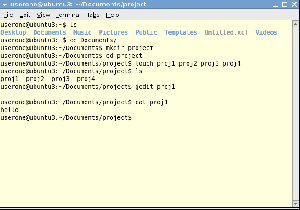Five Interaction Styles
From Computing and Software Wiki
The Five Interaction Styles originally presented by Ben Shneiderman in 1983 represent the five basic ways that humans interact with a computer interface. Each interaction style effects the overall efficiency and usability of the computer system, but that is not to say there are good or bad interaction styles. The styles all have benefits and trade offs when dealing with certain types of users and it is often in an interface designers best interest to use a combination of styles instead of anyone one style alone.
Contents |
Shneiderman's Five Interaction Styles
Visual representation
Visual representation (also known as Direct Manipulation) features a natural representation of task objects and actions. This helps present the process as actually performing a task itself directly even though it is being doing through an intermediary like a computer. The visual representation usually takes the form of a metaphor related to the actual task being performed. In this way well designed visual representation systems tend to make the interaction enjoyable for the users, which is excellent for novice users or complex tasks that can lead to anxiety.
+ Advantages
- Visual presentation of task concepts
- Allows easy learning
- Encourages exploration
- Users can immediately see if their actions are furthering their goals
- Users gain confidence because they feel in control and can predict system responses
- Disadvantages
- Can be hard to implement
- Requires graphics display/pointing devices
Menus
Menus provide a way to visually organise a very large set of actions. Menus are nearly ubiquitous in modern applications, with the most standard format being the "File/Edit" style strip located across the top of windows (such as in Microsoft Windows) or the user's workspace (such as in Multiple Document Interfaces, or in Mac OS X). Menus do not have any obvious physical metaphor, and rely on users being able to tell the difference between an action, and a category which can be expanded into a child set of actions and/or further categories. Menus can also change depending on context, from enabling or disabling individual items depending on the program's state, to using "tabbed toolbars" to flip between item collections.
+ Advantages
- Accessible to novice and intermittent users
- Allows for a very large palette of structured commands which can be easily "explored"
- Facilitates Multiple Document Interfaces well
- Does not rely on parsing input
- Disadvantages
- Can bury useful features under complex hierarchies
- Number of items limited by screen resolution
- Convention restricts how menu items are categorised
Fill-In-The-Blanks
The Fill-In-The-Blanks interaction style (also known as "Form Fill-in") is best suited to data input, which was aimed at a different set of users than command language, specially non-experts users. Originally Fill-In-The-Blanks is to arrange one or more fields in the form of a prose sentence or phrase, with the fields as "blanks" to be filled in by the user. The TAB-key was designed and is still being used to switch between the fields and ENTER to submit the form. Therefore a pointing device (such as a mouse) was not really needed at that time. However it's very common to mix forms with other interaction styles in software design, such as drop down menus, check boxes etc. The spreadsheet is a variation on the Form Fill-in interaction style. Even today, there are quite a few computers are still purely forms-based in the industry, like cash registers, financial systems, stock control systems, and so on. The main reason is because the Fill-In-The-Blanks interface is especially useful for routine, clerical work or those tasks require a great amount of data entry.[1]
+ Advantages
- Simplifies data entry
- Minimal training - Shortens learning in that the fields are predefined and need only be 'recognized'.
- Gives convenient assistance - Guides the user via the predefined rules
- Permits use of form-management tools
- Disadvantages
- Screen space consuming
- requires more keystrokes
- requires handling typing errors (bad for users with poor typing skills)
Command Line
Command line is the earliest used interaction style and is still seen predominantly in Unix operating systems though still usable to varying degrees on Windows and OSX. This style is mainly used by expert users by typing into a prompt that allows them to quickly execute commands. Unfortunately command line places a considerable burden on the user to learn and recall commands from memory. It is often the case that commands take parameters as well and most of the added benefits (mainly in the way of efficiency) come from using them. This leads to an unfriendly environment for both novice and intermediate users that may attempt to use this style. The large overhead in learning commands and minimal help for the user leaves this style almost exclusively in the domain of the expert user.[1]
+ Advantages
- quick and powerful for experienced users
- user-controlled interaction
- minimal amount of typing (no mouse use)
- can be used in conjunction with other user interfaces
- Disadvantages
- little or no prompting
- requires user’s knowledge of system, programs
- relies on recall of commands and syntax
- difficult to learn
- error prone
Natural Language
Natural Language is an interaction style which allows the user to communicate with their computer through a series of spoken commands, similar to how one may issue spoken commands to another person. However the benefits and applicability of Natural Language systems thus far is very limited, largely due to the imprecise and verbose nature of spoken languages. A major issue with using spoken language is that to communicate with computer systems the vocabulary would need to be limited to a specific subset of a full natural language, in order to both reduce ambiguity and keep processing time within reasonable bounds. One solution to the ambiguity of spoken languages is to utilize gestural language, which is considered at least as natural as verbal language. At the same time, the definition of what makes a natural language is very important. It is not as though humans are born knowing spoken word or gestures; a natural language is simply one which can be grasped fluently by the time one is required to draw upon it. A language could be considered natural, if upon approaching a computer the typical user already possesses language skills adequate for communicating desired concepts in a fluent and articulate manner. So in a sense Natural Language could involve a kind of language humans develop with the sole purpose of communicating with computer systems, thus potentially eliminating the ambiguities of the current natural spoken languages. Thus far however Natural Language has not seen widespread use, and often requires each user to train the computer to recognize their own voice. Natural Language could be very useful for those with minimal keyboard skills, and once it more accurately interprets verbal commands may even see widespread use one day. [2][3]
+ Advantages
- Allows users to communicate with their system naturally
- Can reduce or eliminate the need for keyboards, great for those with poor keyboard skills
- Once it is more accurate at interpreting speech, commands may be able to be spoken faster than they are typed
- Disadvantages
- Currently cannot accurately interpret much of verbal language, which is too ambiguous
- Requires a lot of training for each user so it can interpret their verbal commands
See also
- Motivations for the Studies of HCI
- Contexts for HCI
- Process for User-centered Development
- Social issues influencing HCI design and use
- HCI - Accommodating human diversity
- User Interface Standards
- The Object-Action (or visa-versa) model and its applications
- Direct Manipulation
References
- Mads Soegaard, "Interaction Styles", interaction-design.org, http://www.interaction-design.org/encyclopedia/interaction_styles.html
- Byron Long, "Natural Language as an Interaction Style", Retrieved on November 21st, 2009 from http://www.dgp.toronto.edu/people/byron/papers/nli.html
- Bill Buxton, "The "Natural" Language of Interaction", Retrieved on November 21st, 2009 from http://www.billbuxton.com/natural.html
- Microsoft Office Online, "Use the Ribbon - Help and How-to", Retrieved on November 23rd, 2009 from http://office.microsoft.com/en-us/help/HA100898951033.aspx
--Shensw 22:55, 20 November 2009 (EST)
--Collim 23:50, 21 November 2009 (EST)
--Frostd 00:58, 22 November 2009 (EST)
--Simpsoa 15:45, 23 November 2009 (EST)





